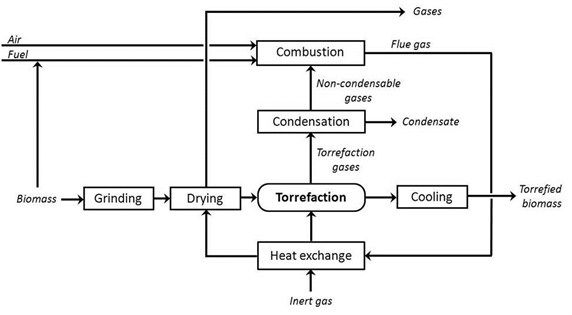Torrefaction

Torrefaction is the process of the thermal pre-treatment of Biomass through heating the material in a range between 200-300°C in the absence of oxygen.
Biomass materials are prepared through grinding and drying at 125°C, resulting in the slight breakdown of the material, release of physical water (moisture) and light volatiles resulting in a weight loss of up to 10%. The Biomass is then heated within a vessel up to temperature of 300°C where chemical water is removed as a product of by-chemical reactions through thermo-condensation along with carbon dioxide formation. In the range of 180-270°C exothermic reactions occur along with the partial degradation of hemicellulose within the Biomass. Subsequently the Biomass attains its brown colour whilst releasing carbon dioxide, chemical moisture, some phenols and large amounts of acetic acid.
Products of torrefaction have considerably higher calorific values (energy per unit of weight) compared to the initial Biomass Feedstock. This ‘torrefied’ Biomass is easy to grind, can be compacted to increase energy density, is hydrophobic so may be stored for a long time, is durable and the homogeneity is improved significantly – resulting in potentially attractive Feedstock for Bioenergy conversion technologies.
Recreate all of graph here:
https://www2.aston.ac.uk/eas/research/groups/ebri/research/[Pyrolysis](/wiki/Pyrolysis)
People who contributed to this article:
Dr. Andrew Welfle